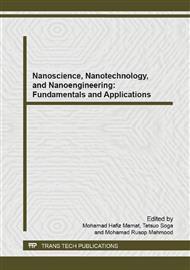p.205
p.210
p.214
p.219
p.223
p.227
p.232
p.238
p.243
SERS-Modeling in Molecular Sensing
Abstract:
Surface enhanced Raman spectroscopy (SERS) is an ultrasensitive vibrational spectroscopic technique that useful tools in detecting biomolecules at near or on the surface of plasmonic nanostructures. Unique physicochemical and optical properties of noble metal nanostructures allow the assimilation of biomolecular probes and exhibit distinctive spectra, prompting the development of a plethora of biosensing platforms in molecular diagnostics. In SERS biosensor, signal to noise ration such as recognition and transducer elements that provide fingerprint spectrum at the lower limit of detection with specific binding or hybridized event, increasing reliability and sensitivity. Since the localized surface plasmon resonance (LSPR) of nanoparticle lies at the heart of SERS. It is essential to control all of the LSPR influencing factors in highly sensitivity signal strength that ensures reproducibility of SERS signals. SERS active substrates, transducer elements, metal surfaces modification, interparticle spacing, dielectric environment and selection of biorecognition molecules contribute in SERS signal strength. Modified metal structure with bioprobe and Raman reporter molecules provides a strong signature fingerprints that surely contribute to noble biosensor structural designing. We reviewed here ideal fabrication of nanostructure for SERS application in molecular sensing research fields.
Info:
Periodical:
Pages:
223-226
Citation:
Online since:
June 2015
Authors:
Keywords:
Price:
Сopyright:
© 2015 Trans Tech Publications Ltd. All Rights Reserved
Share:
Citation:


